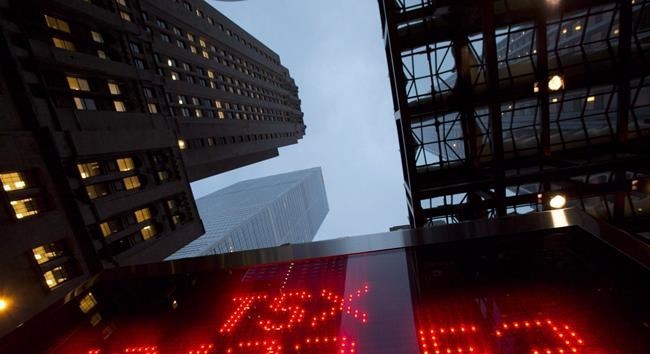TORONTO — Canada's main stock index rose with help from energy sector while the loonie hit a two-year high.
The S&P/TSX composite index closed up 61.28 points to 17,358.21.
In New York, the Dow Jones industrial average was up 59.87 points at 29,883.79. The S&P 500 index was up 6.56 points at 3,669.01, while the Nasdaq composite was down 5.74 points at 12,349.37.
Hurting U.S. markets was Salesforce.com Inc., whose shares dropped 8.7 per cent on the S&P 500 and the Dow, after it agreed to buy workplace messaging app Slack Technologies Inc. for US$27.7 billion.
"Obviously, it was not very well-received by the market in general, so it's having a negative effect on the markets," said Michael Currie, vice-president and investment adviser at TD Wealth.
With U.S. markets generally flat, investors focused largely on the U.K. becoming the first country to green light Pfizer's COVID-19 vaccine.
"The big talk seems to be all about the U.K. getting ready to do the vaccine next week … faster than a lot of people expected and it's having an effect on pretty much everything," Currie said in an interview.
Approval by the large G7 country reinforces the belief that it has a very good chance of passing in other major countries, he said.
Vaccine optimism helped to lift oil prices despite negatives from dissent among OPEC plus Russia about extending supply cuts and a surprise buildup in U.S. oil inventories.
"Oil prices are up a little bit because they figure if this vaccine works then we'll get back to normal quicker and the economy will get back on track," Currie said.
The January crude oil contract was up 73 cents at US$45.28 per barrel and the January natural gas contract was down 10 cents at US$2.78 per mmBTU.
The energy sector gained two per cent on the day with Canada's large producers Vermilion Energy Inc., Husky Energy Inc. and Cenovus Energy Inc. seeing their share prices climb 5.6, 4.8 and 4.2 per cent, respectively.
The Canadian dollar reached its highest level since October 2018 on the back of weakness from the U.S. greenback. It traded for 77.32 cents US compared with 77.21 cents US on Tuesday.
Gold also rose because of the inflationary impact of a stimulus package after U.S. Democratic leaders were supportive of a bipartisan US$900-billion stimulus proposal.
Although initially smaller than expected, the fiscal package is viewed as a basis for negotiations on a larger deal once Republicans concede that Joe Biden beat President Donald Trump, said Currie.
The February gold contract was up US$11.30 at US$1,830.20 an ounce and the March copper contract was up 0.4 of a cent at US$3.49 a pound.
That helped the materials sector to rise slightly.
Health care gained 3.6 per cent on the TSX with Aurora Cannabis Inc. increasing 11.3 per cent. And technology got a lift from a 10.4 per cent increase in Lightspeed POS shares following its second U.S. acquisition in a month.
Financials was also up even as shares of National Bank and Royal Bank fell 1.1 per cent and 0.6 per cent, respectively, after reporting quarterly results.
"Coming on the heels of very good reports out of Scotia and BMO, (it was) a little bit disappointing."
This report by The Canadian Press was first published Dec. 2, 2020.
Companies in this story: (TSX:VET, TSX:HSE, TSX:CVE, TSX:NA, TSX:RY, TSX:ACB, TSX:LSPD, TSX:GSPTSE, TSX:CADUSD=X)
Ross Marowits, The Canadian Press



